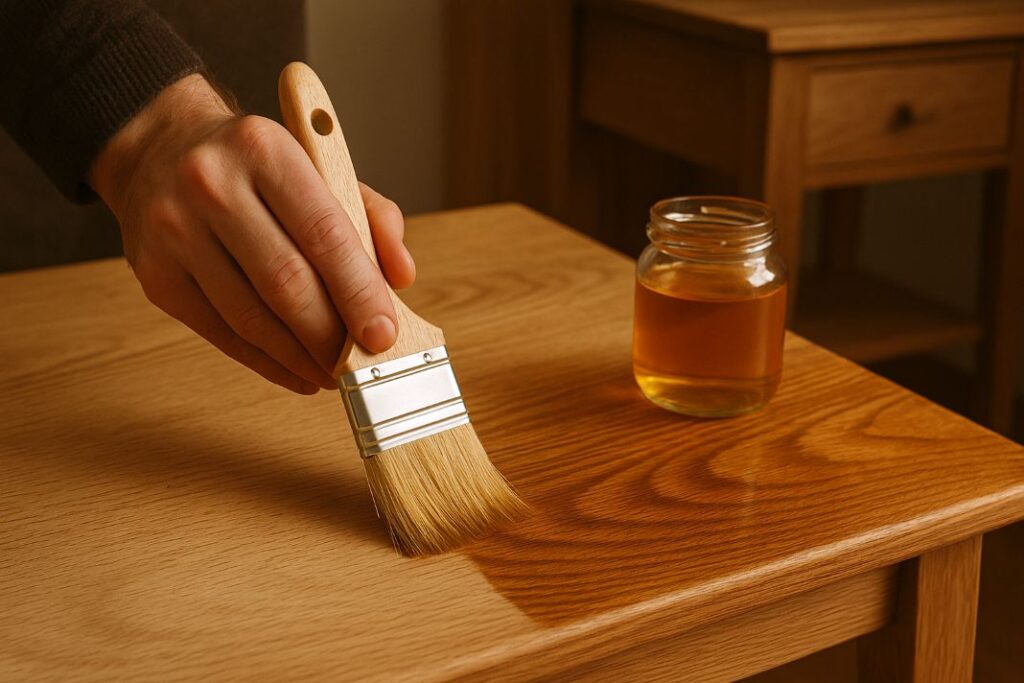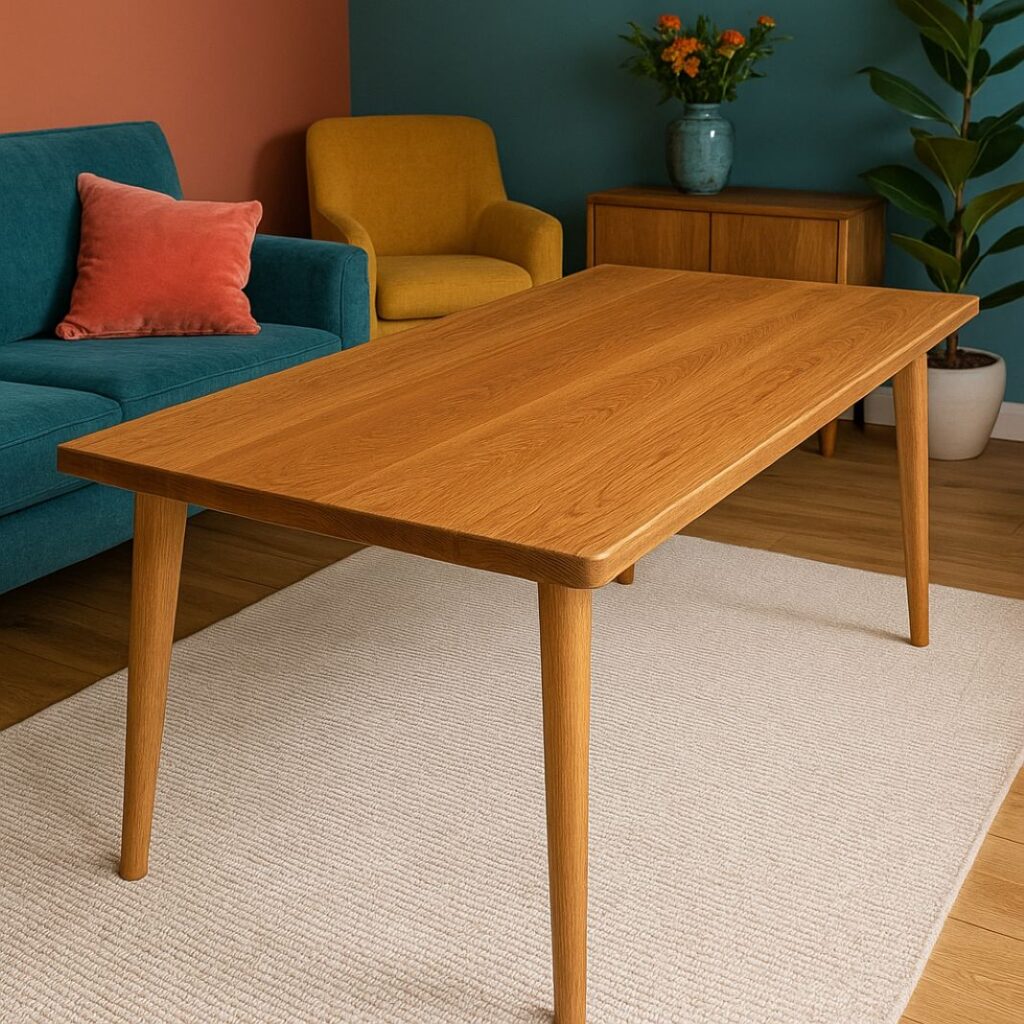
What is Hardwax Oil and Why Is It the Best Finish for Oak Furniture?
Hardwax oil is a professional blend of natural oils and waxes that strengthens and protects wooden furniture without hiding its natural beauty. It penetrates into the oak fibres to enhance structural resilience while forming a breathable layer on the surface that resists stains, water and daily wear. Oak furniture treated with hardwax oil maintains its rich texture and distinctive grain, making it a preferred choice for long lasting protection.
In this article about dining tables for small areas we have covered
- What is hardwax oil and why is it the best finish for oak furniture?
- What is hardwax oil made from?
- How hardwax oil enhances oak grain and colour
- Why is hardwax oil a better choice than danish oil for oak furniture?
- How to apply hardwax oil on oak furniture correctly
- Can hardwax oil be used on antique oak furniture?
- Questions we get asked about hardwax oil for oak furniture
The Beauty and Durability of Oak Furniture
Oak is known for its exceptional durability and attractive grain patterns. It has been a preferred material for furniture makers for centuries due to its strength and visual appeal. Oak tables, chairs and cabinetry bring natural warmth and timeless character to any setting. However, without proper treatment, oak can lose its appearance and suffer damage from moisture or daily use. Applying hardwax oil preserves these valuable qualities while maintaining a natural feel.
What Is Hardwax Oil Made From?
Hardwax oil typically combines linseed oil, tung oil, carnauba wax and beeswax. Some formulations include a mild solvent to improve workability and drying times. The oils penetrate the oak, reinforcing it from within, while the waxes form a durable top layer that protects against water, dirt and scratches. This combination creates a finish that allows the oak to breathe naturally while offering robust protection.
Should You Choose Natural or Synthetic Hardwax Oils?
Natural hardwax oils are derived mainly from plant based oils and natural waxes, offering an environmentally conscious and safer option for homes with children and pets. They produce a more authentic appearance and do not release harmful volatile organic compounds. Some synthetic hardwax oils may include chemical additives for faster curing or increased hardness, but they can alter the feel and appearance of the oak. For residential oak furniture, natural hardwax oils are generally the superior choice for maintaining both beauty and safety.
Pro Tip: Always test hardwax oil on a small hidden area of your oak furniture before full application. This ensures the colour and finish match your expectations without surprises.
How Hardwax Oil Enhances Oak Grain and Colour
Applying hardwax oil to oak furniture deepens the natural tones and highlights the intricate grain patterns. Unlike surface sealants that mask these features, hardwax oil enriches the oak’s natural character. It slightly darkens the timber, enhancing its warmth and depth without creating an artificial gloss unless a specific sheen level is chosen. A well treated oak table or sideboard becomes a centrepiece that showcases the authenticity of the wood.
Does Hardwax Oil Maintain the Texture of Oak Furniture?
Yes, hardwax oil preserves the tactile texture of oak. Because it penetrates rather than forms a thick film, the furniture retains its organic feel. You can still appreciate the natural ridges and contours that make oak furniture distinctive. This quality makes hardwax oil particularly valued for hand finished oak pieces where the touch of the wood is as important as its appearance.
Hardwax Oil Compared to Other Wood Finishes
Traditional finishes like polyurethane varnish create a thick surface coating that can obscure the natural look and feel of oak. While they offer surface protection, they often produce a glossy, synthetic effect. Hardwax oil provides similar levels of resistance to moisture and wear but maintains a more natural, breathable finish. It also allows for easier repair by lightly sanding and reapplying oil to damaged areas without needing to strip the entire surface.
Protect Your Oak Furniture the Right Way
Discover how our expert oak finishing services can keep your tables, chairs and cabinets beautiful and protected for years.
Explore Bespoke TablesWhy Is Hardwax Oil a Better Choice Than Danish Oil for Oak Furniture?
Danish oil and hardwax oil are often compared as finishing options for oak. Danish oil is thinner and often penetrates deeper, but it provides less surface protection. Hardwax oil forms a stronger surface layer while still nourishing the wood internally. This makes it more suitable for furniture that sees regular use, such as oak dining tables or desks. For a full guide on choosing the right finish for your oak furniture, visit our oak furniture care guide.
Which Sheen Level of Hardwax Oil Is Best for Oak Furniture?
Hardwax oils are available in different sheen levels, from matt to satin and gloss. The choice depends on the desired look and function. A matt finish preserves the most natural appearance, ideal for rustic oak pieces. Satin offers a slight sheen that enhances grain visibility without looking overly polished. Gloss finishes reflect more light and can be suitable for more formal furniture settings. Each sheen level still provides the same level of protection when properly applied.
How Does Hardwax Oil Protect Oak Furniture?
Hardwax oil enhances the mechanical strength of oak furniture by filling its pores and hardening within the fibres. The protective surface layer resists liquid spills, dirt and mechanical abrasion. Because the finish remains breathable, it prevents moisture buildup under the surface, reducing the risk of warping or cracking. Regular use of hardwax oil ensures oak furniture retains both its beauty and structural integrity.
Pro Tip: For the smoothest finish, apply the oil thinly along the grain, and never skip the second coat. A second application dramatically improves durability and water resistance for oak.
How to Apply Hardwax Oil on Oak Furniture Correctly
Proper application is important for achieving the best results. Start by sanding the oak surface to a fine finish, typically using 120 to 150 grit sandpaper. Remove all dust with a tack cloth. Apply a thin coat of hardwax oil using a brush, roller or lint free cloth, following the grain of the wood. Allow it to absorb and then wipe off any excess. Let the surface dry completely, usually between four to eight hours depending on conditions. Apply a second coat for enhanced durability.
For more detailed advice, see this full guide on how to apply hardwax oil to oak furniture explains the process step by step.
Maintaining Oak Furniture Finished with Hardwax Oil
Routine maintenance keeps oak furniture looking fresh. Clean surfaces with a damp cloth and avoid harsh chemical cleaners. Reapply a thin layer of hardwax oil when the surface shows signs of dryness or reduced water resistance, typically every one to three years depending on usage. For repairing scratches or stains, gently sand the affected area and reapply oil without needing to refinish the entire piece.
Trusted Brands for Hardwax Oil on Oak Furniture
Leading hardwax oil brands such as Osmo, Fiddes and Treatex offer high quality products suited for oak furniture. These brands provide natural formulations that are durable, food safe and available in various sheen options. Always choose a product specifically formulated for furniture rather than flooring to achieve the best results.
Can Hardwax Oil Be Used on Antique Oak Furniture?
Yes, hardwax oil is a suitable choice for restoring antique oak furniture. It offers protection without changing the historical look or feel of aged wood. When applying to antiques, careful surface preparation is important to avoid damaging original features. For particularly valuable pieces, consult a professional conservator.
Common Problems with Hardwax Oil Finishes and How to Avoid Them
Tackiness after drying usually results from applying too much oil or not wiping off the excess. Uneven sheen can occur if the oil is not distributed evenly during application. These problems are easy to avoid by applying thin, even coats and allowing proper drying time between layers. If an issue occurs, lightly sand the area and reapply a thin coat of oil.
Need Help Restoring Your Oak Furniture?
Our professional restoration team brings worn or damaged oak pieces back to life with natural, durable finishes.
Restore My Old Oak PieceFrequently Asked Questions About Hardwax Oil for Oak Furniture
How often should I reapply hardwax oil on oak furniture?
Generally, hardwax oil for oak furniture should be reoiled every one to three years depending on usage and environmental conditions. High traffic surfaces like dining tables may need more frequent maintenance.
Is hardwax oil suitable for oak dining tables exposed to frequent spills?
Yes, hardwax oil creates a water resistant surface that protects oak dining tables from spills. For the best results, ensure spills are wiped up promptly and maintain the finish with occasional reapplication.
Can hardwax oil be applied over existing finishes on oak?
Hardwax oil should be applied directly onto bare wood for the best results. Existing varnish, lacquer or heavy wax coatings should be fully removed before application to ensure proper absorption and bonding.
What is the best sheen level for oak furniture?
The best sheen level depends on your personal preference and the style of your furniture. Matt offers a natural look, satin provides a soft glow without excessive shine, and gloss creates a more reflective finish for formal settings.
Is hardwax oil safe for children’s oak furniture?
Yes, reputable hardwax oils are tested and certified as food safe and child safe once fully cured. Always check that the product label confirms suitability for toys and food preparation surfaces.
Tablemaker
55 High St, London N8 7QB
02083416334
HVQM+58 London




